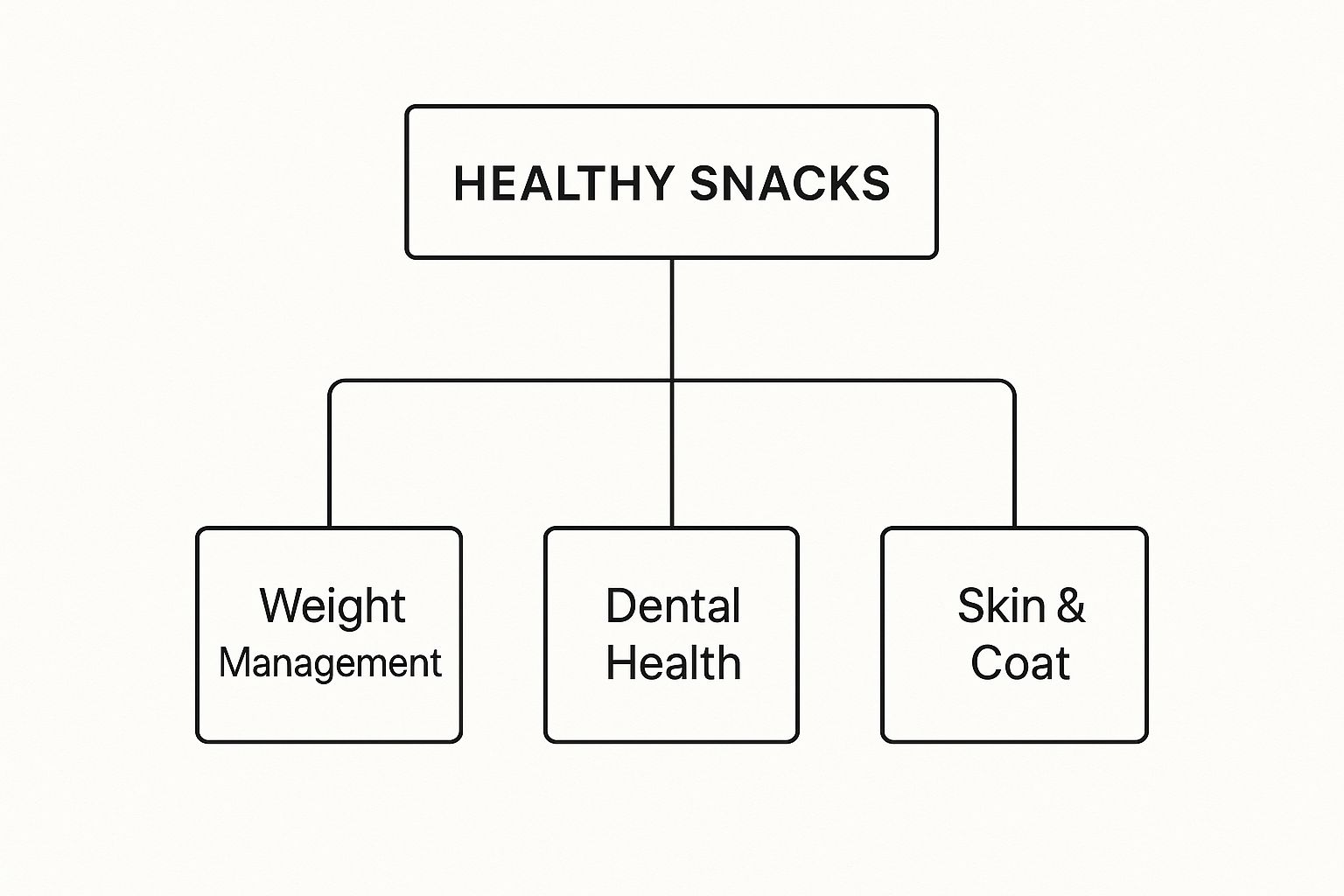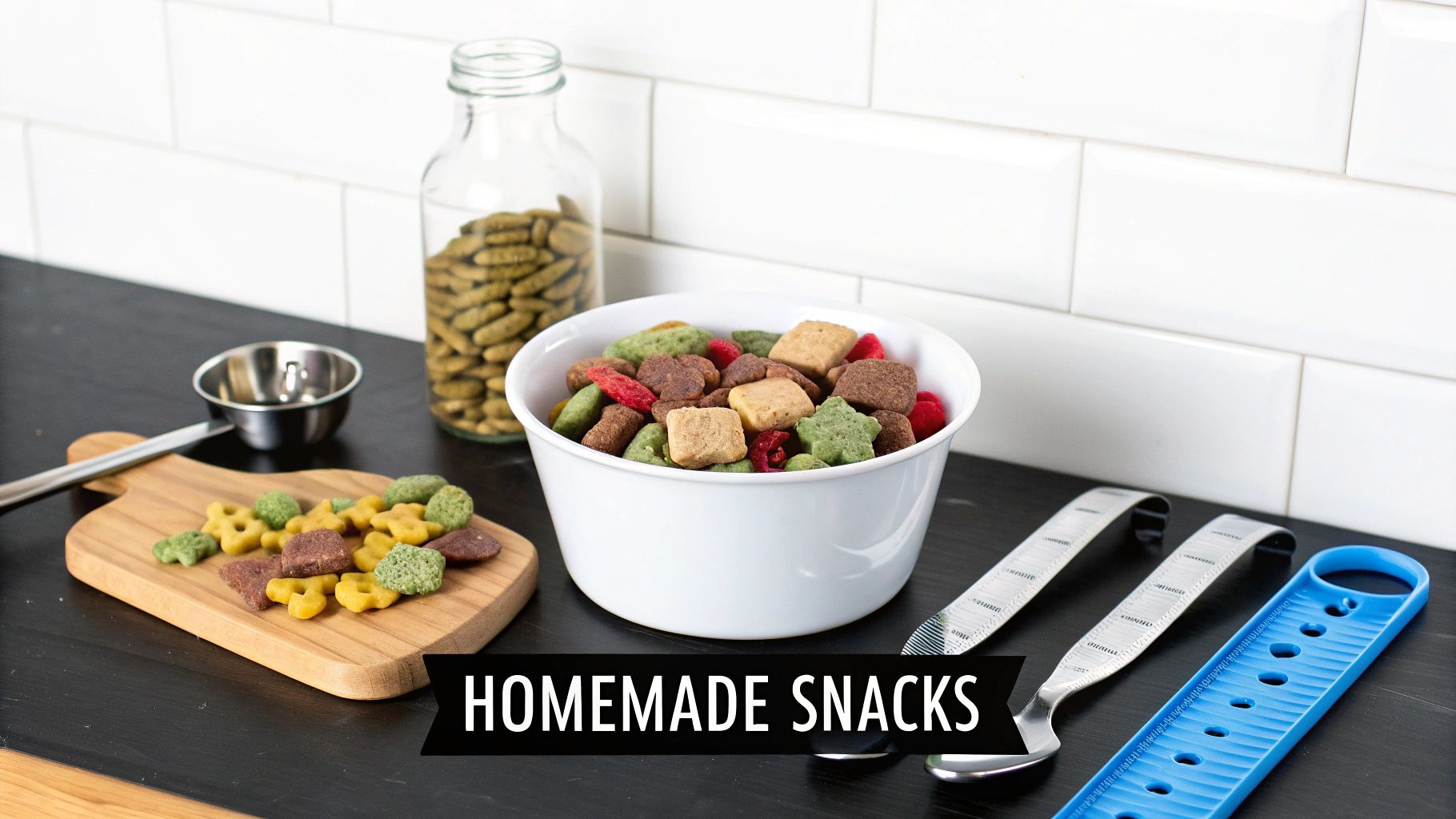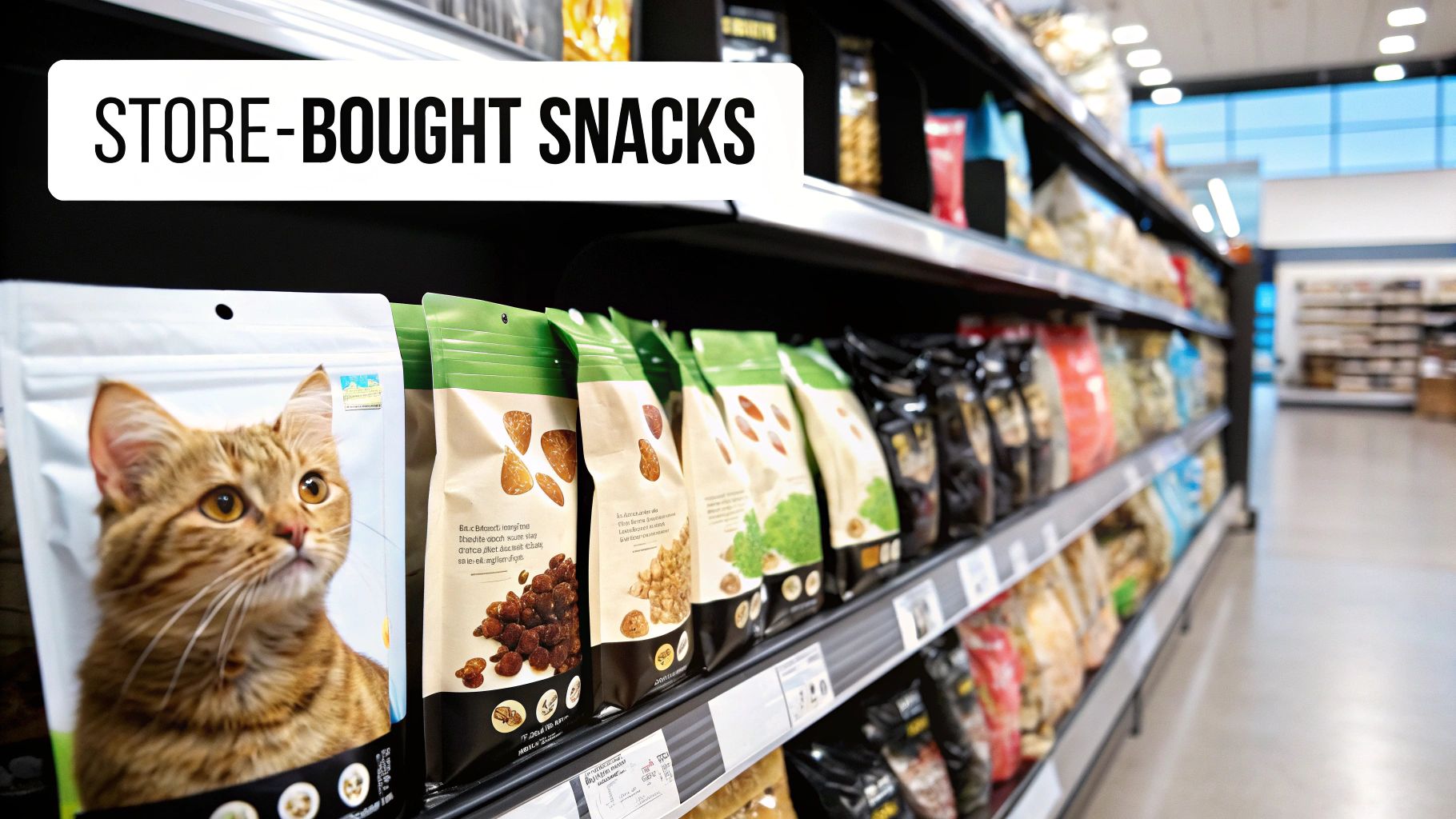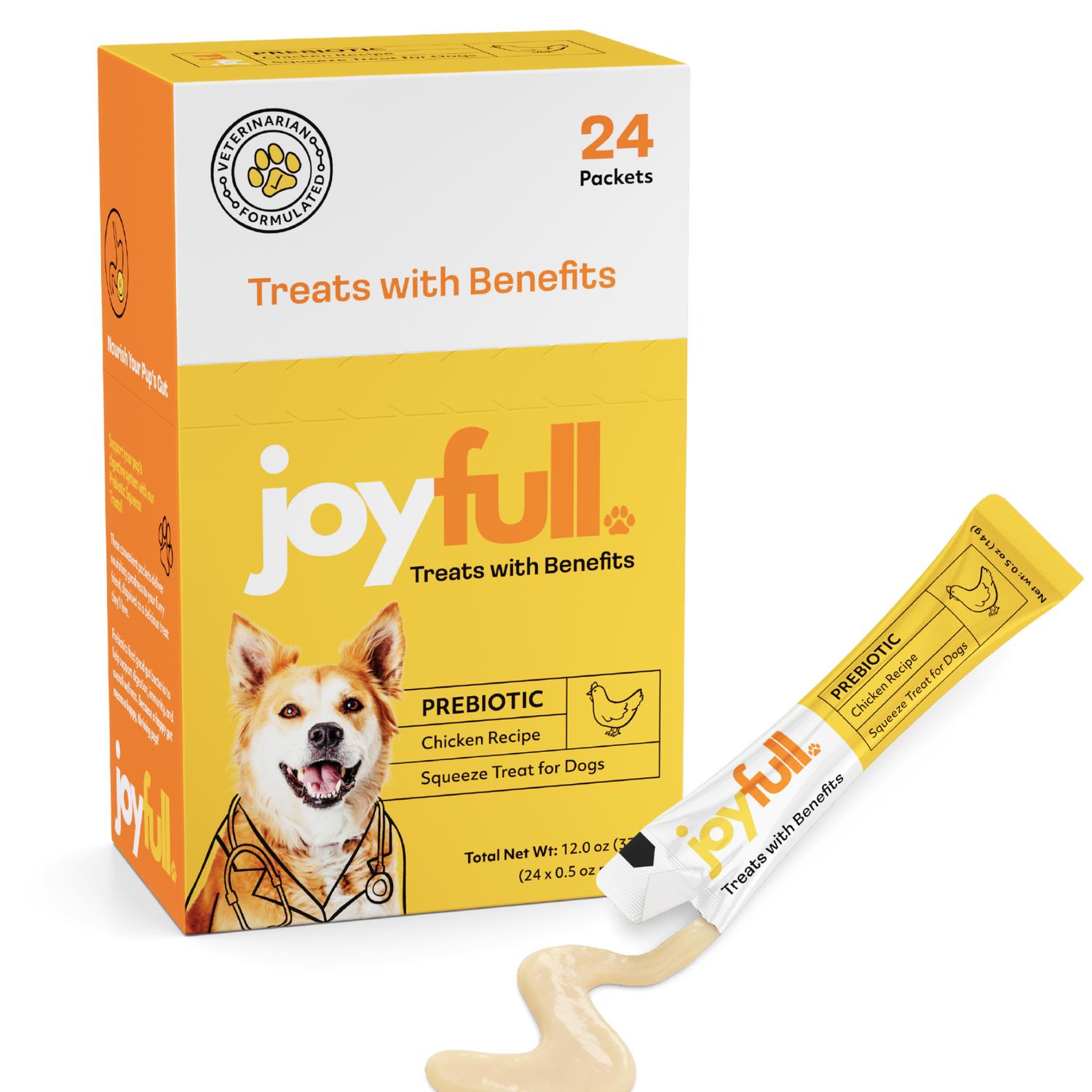
Healthy Snacks for Cats Your Feline Will Adore
When we talk about snacks for our cats, it's easy to fall into the human mindset of a little "treat" or indulgence. But for our feline friends, a snack should be much more than a tasty bite—it needs to be a functional, nutritious part of their diet. Think of it as a protein-packed supplement, not a sugary dessert.
What Makes a Cat Snack Genuinely Healthy
Cats are obligate carnivores, a term that gets thrown around a lot but is critical to understand. It simply means their bodies are fine-tuned to thrive on nutrients found only in animal tissue. Their digestive systems just aren't built to handle a lot of carbohydrates from plants.
This is why the cornerstone of any truly healthy cat snack is high-quality animal protein. Real chicken, turkey, or fish isn't just a flavor—it's the source of essential amino acids like taurine and arginine, which cats can't make on their own. These nutrients are absolutely vital for everything from their vision and heart function to a strong immune system. A snack missing this protein foundation is, for a cat, just junk food.
A healthy cat snack is like a targeted, species-appropriate protein bar for an athlete. It provides the right fuel and building blocks for their body. In contrast, a low-quality, carb-heavy treat is like a candy bar—it delivers empty calories that can lead to weight gain without offering any real nutritional value.
As more of us see our pets as true members of the family, the desire for premium, health-first treats has exploded. In fact, the global cat food and snack market is on track to hit USD 69.60 billion by 2035. This growth is fueled by cat parents actively looking for treats that address specific feline health needs. You can dig into more data on this growing market trend and see how it's shaping pet wellness.
The image below gives a great visual breakdown of how the right kind of snacking can support your cat's overall well-being.

As you can see, choosing snacks wisely isn't just about preventing harm; it's about actively contributing to weight management, better dental health, and a healthy, vibrant coat.
Healthy Cat Snack Checklist
When you're standing in the pet food aisle, it can be tough to tell the good from the bad. This little checklist should make it easier to spot what your cat really needs.
| Look For (The Good Stuff) | Avoid (The Bad Stuff) |
|---|---|
| Real, named animal protein (e.g., chicken, tuna, beef) | Vague "meat" or "animal" derivatives |
| Single-ingredient or limited-ingredient lists | Artificial colors, flavors, or preservatives |
| Grain-free or low-carbohydrate formulas | Fillers like corn, wheat, and soy |
| Nutrients like taurine and omega fatty acids | High sugar content (e.g., molasses, corn syrup) |
| Freeze-dried or air-dried options | Propylene glycol (a humectant) |
Remember, a short, understandable ingredient list is almost always a good sign. The goal is to find treats that add nutritional value, not just empty calories, to your cat's day.
How to Decode Cat Treat Ingredient Labels
Let's be honest, trying to read a pet food label can feel like deciphering a secret code. The long lists of unfamiliar ingredients and confusing terms can be overwhelming. But here's the good news: you don't need a degree in animal nutrition to make great choices for your cat. With a little know-how, you can see right past the fancy marketing and find the good stuff.
The first and most important trick is to focus on the first five ingredients. That's because ingredients are listed by weight, so whatever is at the top of the list makes up most of the treat. You want to see a real, identifiable animal protein right at the top—think "chicken," "salmon," or "turkey." What you don't want to see are vague phrases like "meat by-products."

Spotting Quality Versus Fillers
Okay, so you’ve found a treat with a quality protein leading the charge. Great start! The next step is to scan for cheap "fillers." These are ingredients, usually carbohydrates, that companies use to bulk up their products without adding much real nutritional value for a cat.
Keep an eye out for these common fillers:
- Corn (and things like corn gluten meal)
- Wheat and wheat gluten
- Soy in any form
Cats are obligate carnivores, meaning their bodies are designed to thrive on meat. Fillers just don't provide the species-appropriate nutrition they need. When you’re looking for healthy snacks for your cat, protein should always win out over fillers. To really dig into this, check out our guide on the benefits of high-protein cat treats.
One of the most confusing terms you'll see is “meat by-products.” It sounds a bit sketchy, right? While not necessarily harmful, the term is incredibly vague. It could mean nutritious organ meats, but it could also refer to less desirable parts. By sticking to treats with named proteins, you take all the guesswork out of the equation.
It’s no surprise that the pet treat market is huge and still growing—it's expected to hit USD 138.73 billion by 2034. More and more, we see our pets as family and want the best for them. In fact, an estimated 60-70% of cat owners now actively look for snacks with health benefits, which makes knowing how to read a label more important than ever.
Choosing Functional Snacks for Better Health

Cat snacks have come a long way from just being simple, tasty morsels. These days, a treat can be so much more. Think of it as a chance to boost your cat's health in a way they'll absolutely love. We call these functional snacks, and they’re designed to turn snack time into a genuinely beneficial part of your cat’s daily routine.
Essentially, these treats are like supplements cleverly disguised as a delicious reward. Each one is packed with specific ingredients to help with common feline health issues. This move toward health-first products is huge in the pet food world. The global cat food market, which includes these smart snacks, was valued at USD 37.07 billion in 2024 and is still climbing. If you're curious about this trend, you can read more about the cat food market forecast.
Targeting Specific Wellness Needs
Instead of a one-size-fits-all treat, functional snacks let you tailor your cat’s diet to their unique needs. By picking the right snack, you can add targeted benefits that support their main meals.
So, what can these healthy cat snacks actually do? Here are a few great examples:
- Improve Dental Health: Certain treats have a special texture designed to gently scrub away tartar as your cat chews, which is fantastic for their gums.
- Manage Hairballs: Snacks with extra fiber can help ingested fur pass smoothly through the digestive system, making those unpleasant hairballs less common.
- Support Skin and Coat: Look for options with omega-3 and omega-6 fatty acids. These nutrients nourish the skin from the inside out, leading to a much softer, shinier coat.
Functional snacks transform treat time from a simple indulgence into a meaningful health benefit. They are a simple yet effective way to add an extra layer of care to your cat's daily life.
You can also find formulas that focus on other areas. Some use probiotics to help with digestive balance, while others include ingredients like glucosamine to support joint health and mobility, especially in older cats. When you choose the right functional snack, you're making sure every single bite does more for your cat’s well-being.
Safe Human Foods Cats Can Enjoy

It’s completely natural to want to share a little taste of your meal with your furry companion. While snacks made specifically for cats are always the best choice, the good news is you don't always have to resist those pleading eyes. Several human foods are perfectly safe for cats, as long as they're treated as rare indulgences, not everyday snacks.
The trick is to keep it simple and unseasoned. Since cats are obligate carnivores, their bodies are designed to thrive on animal protein. A tiny bit of plain, cooked chicken or turkey breast is usually a massive hit. Just be sure to remove any skin or fat, and never serve it with salt, garlic, or onions, which are toxic to cats.
Feline-Friendly People Food
So, what else from your plate can you share? The key is portion control. A safe amount is incredibly small—think no bigger than the tip of your pinky finger. This prevents digestive issues and keeps their calorie intake in check.
Here are a few surprisingly safe options you can offer:
- Cooked Fish: A small flake of cooked salmon or tuna (the kind canned in water, not oil) is a fantastic source of healthy omega-3 fatty acids. Always double-check for bones before sharing.
- Scrambled Eggs: Cats can enjoy a tiny spoonful of plain, fully cooked scrambled egg. Just cook it without any milk, butter, or seasoning.
- Select Fruits: Believe it or not, some cats enjoy tiny cubes of cantaloupe or watermelon, which offer a bit of hydration. Don't be surprised if your cat is completely unimpressed, though!
- Steamed Veggies: Small pieces of steamed broccoli or green beans can add a little fiber. Again, many felines will simply sniff and walk away.
The golden rule for sharing human food is moderation and proper preparation. A food that's safe plain can quickly become harmful when you add seasonings, oils, or sauces.
Ultimately, these occasional bites should only ever complement a diet built on high-quality cat food and specially formulated treats. If you're feeling adventurous and want to try making balanced goodies in your own kitchen, check out our guide to healthy homemade cat treats. By keeping things simple, you can safely let your cat have a little taste of your world.
Dangerous Foods You Must Keep Away from Your Cat
It’s tempting to share a little bite of your dinner with your cat, but before you do, it's crucial to know what’s safe and what’s not. Many of the foods we eat every day are surprisingly toxic to our feline friends, turning a seemingly harmless treat into a potential emergency.
A cat’s body is a finely tuned machine built for a carnivorous diet. Their metabolism simply isn't equipped to handle certain compounds found in plants and human-made foods. What’s a simple ingredient for us can lead to anything from an upset stomach to life-threatening organ damage for them. This makes kitchen safety a non-negotiable part of being a responsible cat owner.
Common Household Toxins for Cats
Keeping your cat safe means being vigilant about what you leave on your counters or accidentally drop on the floor. Some of the most common culprits are probably in your kitchen right now.
Here’s a clear list of what you absolutely must keep out of your cat's reach:
-
Onions, Garlic, and Chives: It doesn't matter if they're raw, cooked, or in powder form. Every part of the allium family (which includes these plants) can damage a cat’s red blood cells and lead to a dangerous form of anemia.
-
Chocolate: This is a big one. Chocolate contains two stimulants, theobromine and caffeine, that are highly toxic to cats. The darker the chocolate, the more dangerous it is, but you should avoid letting your cat have any type at all.
-
Grapes and Raisins: While the exact toxin is still a mystery, we know for a fact that these fruits can cause sudden and severe kidney failure in cats.
-
Alcohol and Caffeine: This includes everything from a spilled cocktail to your morning coffee or tea. Even a tiny amount can cause serious liver and brain damage in a cat.
Perhaps the most critical hidden danger is xylitol. This is an artificial sweetener found in countless sugar-free products—think gum, candy, some peanut butters, and even certain baked goods. While its toxicity is more widely documented in dogs, it's a risk no cat owner should take.
When you know the risks, you can turn your home into a true safe haven for your furry companion. If you’re ever in doubt, the best rule of thumb is to stick with treats that were made specifically for a cat’s unique dietary needs.
Smart Snacking Without the Weight Gain
We all love spoiling our cats, and offering a tasty treat feels like a perfect way to show our affection. But it's a slippery slope. Before you know it, those little "I love you" snacks can start to pack on the pounds. The trick is to stop thinking of treats as extra food and start seeing them as a small, intentional part of your cat's daily diet.
A fantastic rule of thumb that I always share with cat owners is the 10% rule. It’s simple: treats should account for no more than 10% of your cat’s total daily calories. So, if your cat's diet is around 250 calories per day, that means a maximum of 25 of those calories should come from snacks. Sticking to this helps maintain a balanced diet and wards off obesity, which is a very real and serious risk, especially for our indoor companions.
Make Treat Time an Activity
Instead of just tossing a treat on the floor, why not turn snack time into an event? Using healthy snacks as a reward during a clicker training session, for instance, is a brilliant way to make that treat feel earned and special.
You can also fire up their natural hunting instincts and give their brain a workout. Try:
- Hiding a few treats around the house for a fun game of "find it."
- Tucking the snacks inside a puzzle feeder, which makes them think and problem-solve to get their prize.
When you turn snack time into a game, you're doing more than just feeding them. You're providing mental enrichment and physical activity, which deepens your bond and makes that treat a meaningful part of their day, not just empty calories.
By building these small habits, you can keep enjoying those special moments with your cat. You’ll be nurturing your relationship while protecting their long-term health, no compromises needed.
Common Questions About Healthy Cat Snacks
Let's be honest, figuring out the right way to give your cat snacks can feel a bit confusing. You want to do what's best, but the advice out there can sometimes feel contradictory. We get it. Here, we'll clear up some of the most common questions we hear from cat parents, giving you the straightforward answers you need to treat your feline friend with confidence.
How Many Snacks Can My Cat Have?
This is probably the number one question on every cat owner's mind. The best rule of thumb to follow is the 10% rule. This means that treats should never account for more than 10% of your cat's total daily calories.
For a typical adult cat that eats around 250 calories a day, this means snacks should only add up to about 25 calories. That’s not a lot—it usually equals just a few small, low-calorie treats.
It's so easy to overdo it, but over-treating is one of the main causes of feline obesity. Sticking to that 10% isn't just a suggestion; it’s a crucial part of keeping your cat at a healthy weight and avoiding serious health issues down the road.
Are Grain-Free Snacks Actually Better?
This is another big one. You see "grain-free" advertised everywhere, but does it automatically mean a snack is healthier? Not always.
Cats are obligate carnivores, so they don’t have a biological need for grains. That part is true. But many grain-free snacks just swap out grains for other starchy fillers like potatoes or peas, which don't offer much nutritional value for your cat.
What truly matters is seeing a high-quality animal protein as the very first ingredient. A treat that leads with a named meat, like chicken or salmon, is almost always going to be a better choice than a grain-free one packed with starches. Always read the whole ingredient list, not just the marketing claims on the front of the bag.
If you're interested in making your own balanced snacks, our article on healthy homemade cat treats has some fantastic ideas to get you started.
Can Kittens Eat the Same Snacks as Adult Cats?
It's best to avoid this. Kittens have very different nutritional requirements than adult cats. Their growing bodies need more protein, fat, and specific nutrients like DHA to support healthy brain development.
Snacks made for adult cats won't provide this specialized nutrition and could even be a choking hazard if they're too big or hard for a kitten's small mouth. Always look for treats formulated specifically for their life stage.
At JoyFull, we believe a treat should be more than just tasty—it should be truly good for your pet. That's why we craft our snacks with clean, simple ingredients and high-quality proteins. Every recipe is scientifically reviewed to ensure it supports your cat's health and happiness.
You can check out our wholesome options at https://joyfullpet.com.

